自我形象演绎中的成长
在西方艺术史中,有一个门类的绘画常常被人忽视,这个门类对于艺术家来说又是至关重要,它们是艺术家自己的镜子,证明着自己的存在。这就是自画像。对于艺术家来说,自画像远不是练习作品那么简单。1000多年前,艺术家的签名出现在艺术品上。艺术家从此不再是手艺人,而成为“大家”被人尊重,被历史记录下来。相同的,自画像的存在无疑代表着艺术家地位的提升,他们不再是沉默的记录者,反而走上主角的位置,用自己的笔传递着自己独一无二的个性和生命故事。在没有摄影技术的时代,这种对于自身的记录,是艺术家们独有的天赋。对于这些以图像为生存工具的艺术家来说,他们对于图形的敏感远远超过文字。所以与其去写传记,他们不如使用自己的特权,让不同阶段的自己永久保存下来。穿越了时空,忠实的记录自己的内心。
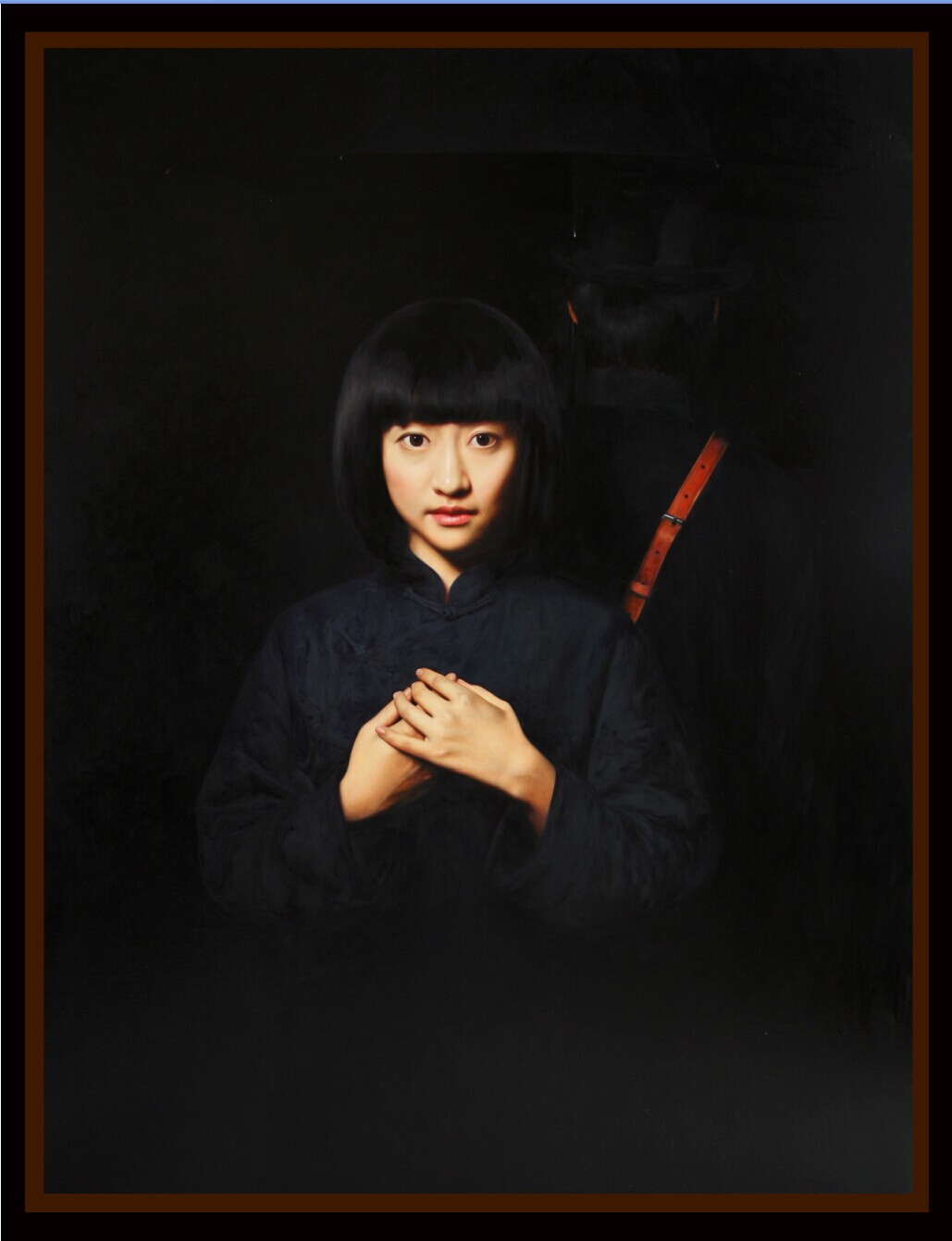
对于人类如何认识自己这一深奥的哲学问题,大部分艺术家也没有具体的答案。陈承卫大约也是如此。梵高给弟弟特奥的信中曾经写道“虽然不易,但如果有一天我能画好自己的肖像,那我就能轻松画出这世间其他红男绿女的肖像了。”人们想要描绘自己是不易的,因为谁也不能看清自己。而自画像的练习不仅有助于画家练习造型与色彩,还可通过自我观察,深入探索形象的精神气质与心理活动的外在显现。当艺术家能够通过描绘自己抓住自己隐藏的心理时,他们便能够真正的抓住“这世间其他红男绿女”微翘的嘴角,含羞的眼波或者略带忧愁的眉脚了。这大概也是陈承卫一直以来坚持画自己的形象的原因之一,这是一种练习,同时也是一种审视。用眼睛品读世界的艺术家们总是用画画的方式审视自己的内心,我常常认为这样的艺术家都是勇敢的。他们通过作画,勇敢的寻找着内心。也许在这个时候,时间和脑海才能真正的安静下来,让他们充满创造力的脑海集中精力。
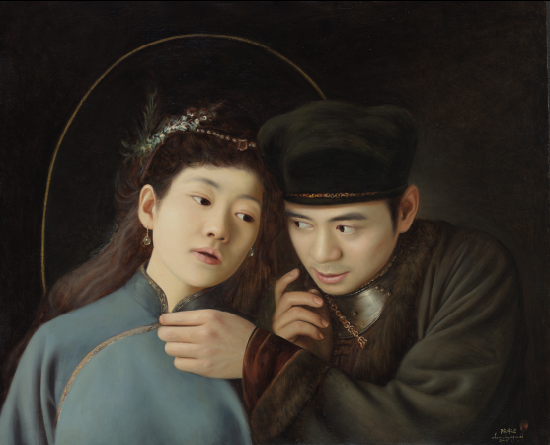
陈承卫就是一个勇敢的人,一直坚持不懈的描绘着自己。无论是“自传体”系列或者是“大民国”系列中艺术家穿插在画作中扮演的各种形象,都是艺术家对于自我写照的不断探索。
西方艺术史中,对于艺术家自我形象的认识也经历了漫长的过程,有趣的是这个过程在陈承卫的作品中则是逆向进行的。艺术史上很早以前艺术家们就开始将自己的形象拐弯抹角的隐藏在作品之中,最著名的无过于委拉斯凯兹《宫娥》镜中倒影的艺术家本人,是戏谑也是一种对于自己身份的认可。艺术家们不再甘愿为贵族王室作画,而是骄傲的将自己的形象也置于架上,这种半恶作剧的传统可以被视作自画像的前身。到后来干脆直接为自己作画,骄傲的告诉世人,我就是我。扬•凡•艾克1433年就在自己的自画像《戴红头巾的男子》顶部写下“尽我所能”。画的底部,还戏谑性的写下了一句“扬•凡•艾克描绘了我,1433年10月21日”。毕加索这位艺术巨匠也在去世前将全部心力用到自画像创作上来。自画像从开始对于艺术家职业价值的认识,最终成为艺术家展示个性和自身生命故事的演变。
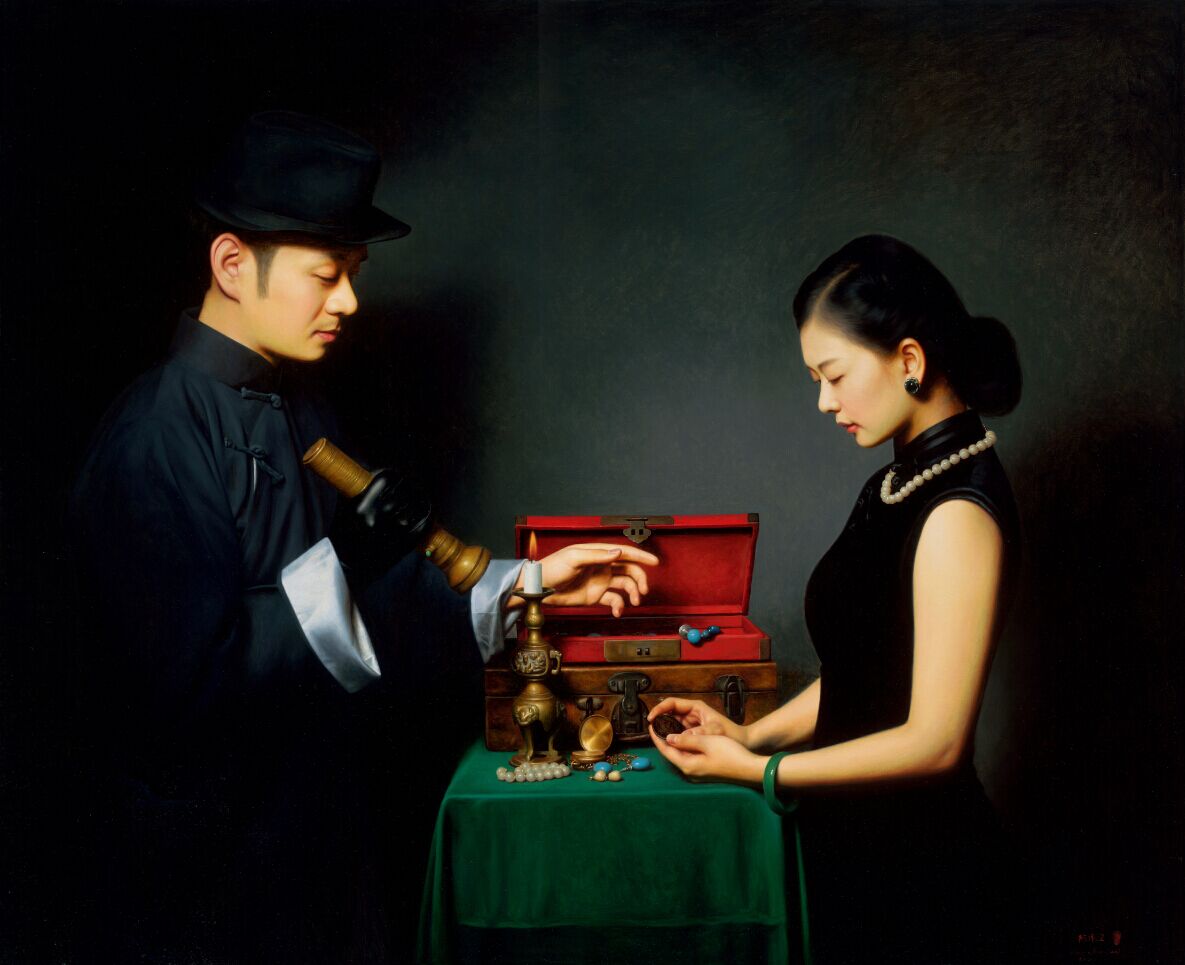
作为一位年轻的艺术家,陈承卫的早期作品反倒是比较直接的自我展示。大概是因为出生在这个时代,艺术家已经能够非常自信的面对自己的价值。相信他对于伦勃朗的喜爱可能也是原因之一,“自传体”系列明显是对于这位巴洛克时期大师的致敬。善以概括手法表现人物的性格特征的伦勃朗精于心理描写的肖像画和自画像作品,他集大成的“明暗对比法”被誉为“用黑暗绘就光明”。“自传体”系列中,来自伦勃朗的明暗对比光影使用、戏剧色彩、以及四分之三侧脸肖像的构图特点清晰可见。陈承卫对于伦勃朗式用光的使用已经非常娴熟而灵活。光线仅照亮脸部的四分之三,在主要形象脸部的任意一侧呈现出倒三角形的亮区。看上去将脸部一分为二,又使脸部的两侧看上去各不相同。将光线集中在主要部分,让其余部分隐藏于黑褐色或浅橄榄色的背景之中。强化画中的主要部分,也让暗部去弱化和消融次要因素。给人以稳定庄重华丽的感觉,更让“自传体”系列带上了巴洛克时代的神秘感,魔术般的点亮了原本平实的主题中戏剧性色彩。
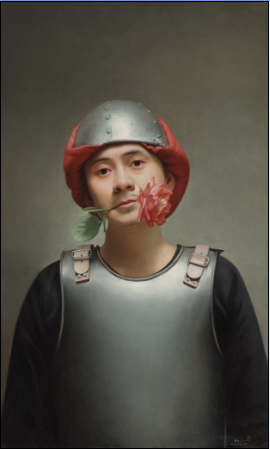
伦勃朗的一生中共有61幅自画像,在这一系列的自画像中,我们可以看到伦勃朗始终不屈不挠的性格,他倾尽一生都在描绘自己的皮肤、头发和纹理,勇敢的记录自己的痛苦、哀伤、不羁与快乐,这种描绘与自我分析在伦勃朗的生命中已经被视为尊严。于陈承卫的作品中也是如此。他总是在画面中直视外面的世界,带着笑意,无论带上弄臣的帽子还是装成贵族。看着他的自画像能够感受到一种强烈的信心,只要他还能继续作画、创作,他的尊严就不会泯灭。
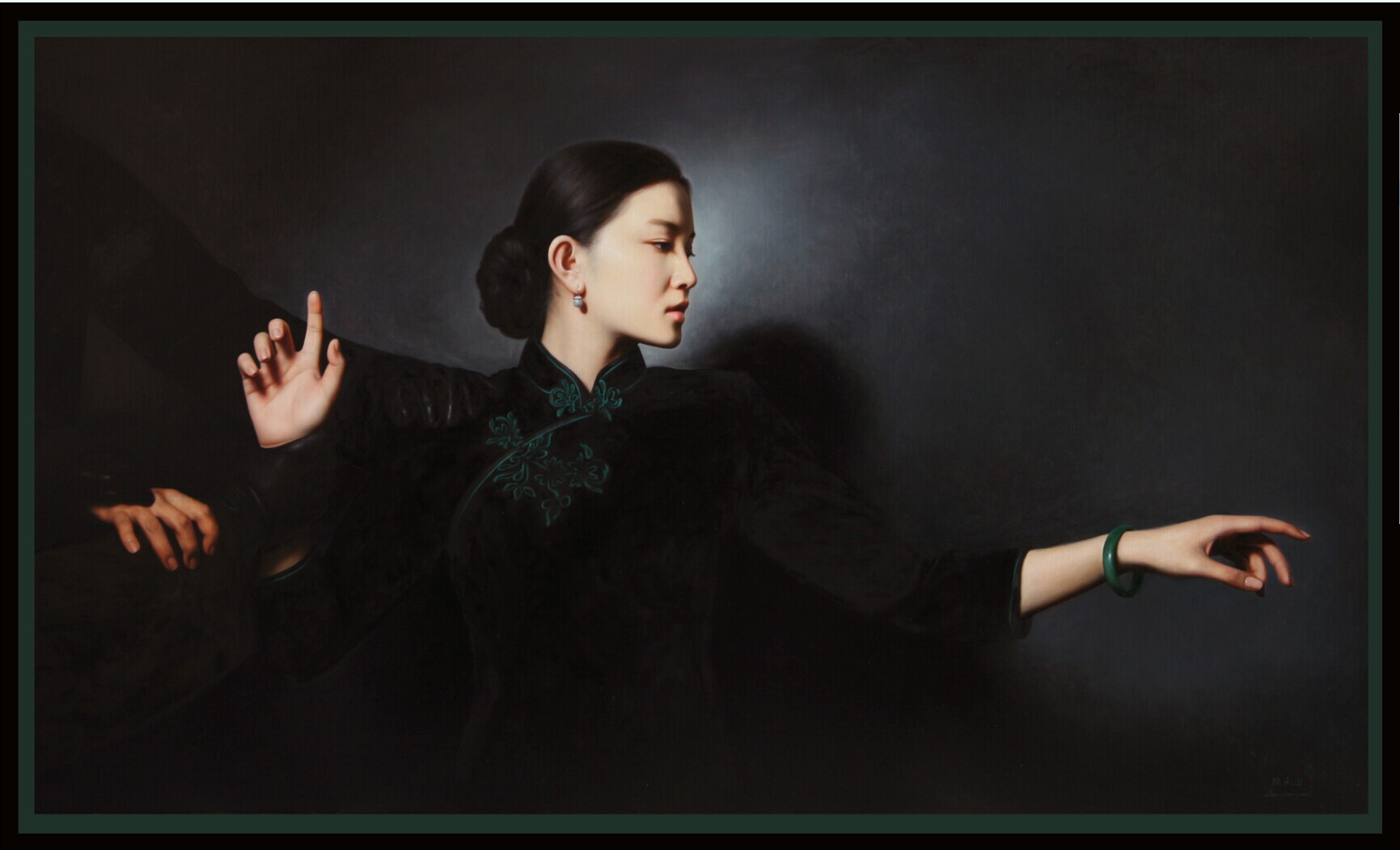
另一方面,戏剧性在陈承卫的作品中也占据了很重要的地位,尤其是“大民国”系列中艺术家对于大民国时期富有符号性的演绎。艺术家如前文提到的委拉斯凯兹,将自己穿插在大民国的各个场景之中,在压抑中自我寻找,体验不同的情境不同的生活。用自己纯熟的画工,将写实主义与中国当今的古典主义审美完美结合,并将自己的想象融入在作品之中。分散在各个作品中的红色绸缎,具有政治寓意性,又有传统婚姻对于女性枷锁的隐喻。另一方面,作为一名年轻的艺术家,难得的是我们通过陈承卫艺术表现的成长过程,看到得是越来越复杂的艺术表现与思考,而非因为审美趋同及利益驱使,走向媚俗与平庸的流程化创作,这一点十分可贵。最明显看到艺术家成长既是对于张爱玲名作《红玫瑰与白玫瑰》的演绎。丰富的符号隐藏在作品当中,将男主角振保德心理状态表现的淋漓尽致。“也许每一个男子全都有过这样的两个女人,至少两个。娶了红玫瑰,久而久之,红的变了墙上的一抹蚊子血,白的还是"床前明月光";娶了白玫瑰,白的便是衣服上沾的一粒饭黏子,红的却是心口上一颗朱砂痣。” 作品“红玫瑰”中,男子的帽子虽是红色,却身着白衣。红玫瑰是振保心中的一颗“朱砂痣”,即使穿着应与白玫瑰结合的白衣,却急迫地将象征心与火热的红玫瑰送给红衣女郎。只是这朵玫瑰已经开始凋零亦或者从未完全开放,就如小说中后续的故事,在红玫瑰终于回过身认真的面对与振保的关系时,振保选择了懦弱的离开。而作品“白玫瑰”就像前作的续写,大红色的绸花前,白色衣着的二人目视前方,毫无表情更无激情。一朵白玫瑰挡在白色肚兜暗示心与热情的红色花纹前,男子则防御性的双手相交。这或许便是传统意义上相敬如宾的夫妻,两人虽站在一起却如相隔千里。然而另一只手却从画面外伸向女子的肩头,暗示振保最终发现妻子与裁缝保持暧昧的未来。
所以在我眼中,陈承卫一直在自我形象的演绎中不断成长。通过绘画,他试图在不同时空中寻找另一个自己。
高鹏 博士
今日美术馆 馆长
2015.8.17 写于北京

Making Progresses Through the Exploration of Self-portrait Painting
There is a category of paintings usually ignored in western art history, which, however, matters a lot to artists, for it is their mirror and proves their existence. It is self-portrait. For artists, painting self-portraits is in no way as simple as practicing drawing. Artists’ signatures began to appear on artworks 1,000 year ago. Since then, artists have no longer been called craftsmen but “masters” respected by people and recorded by history. Likewise, the emergence of self-portraits symbolizes undoubtedly the rising status of artists, that is, artists are no longer silent recorders but protagonists that depict their own unique personalities and life stories with their brushes. In an era without photographic techniques, such kind of self-portrayal can be achieved only by artists with their unique expertise. Those artists who earn a living by painting are much more sensitive about drawings than words. Consequently, they would rather use their privileges to record themselves of different phases than write autobiographies, faithfully depicting their inner feelings across time and space.
Most artists have no concrete answers to the profound philosophical question of how we as human beings getting to know ourselves. I think there is no exception to Chen Chengwei for the same question. Vincent Willem van Gogh once said to his brother Theo in a letter that “If one day I can paint my self-portrait well although it’s hard, then I can paint easily portraits of the other men and women in the world.” It is not easy for people to paint themselves, for no one can see themselves clearly. But self-portrait practice can help painters not only practice modeling and colors, but also probe into spiritual temperament of images and external manifestation of mental activities through self-observation. When artists are able to seize their hidden mentality through depicting themselves, they can really capture the lips curving slightly, shy light in the eyes or eyebrow with slight gloom of “the other men and women in the world”. And that might be one of the reasons that Chen Chengwei has been insisting on painting self-portraits, which is a practice as well as an observation. Artists reading the world with eyes can always inspect their hearts by means of painting and I think these artists are brave. They are pursuing their hearts bravely through painting. Maybe it is at that moment that time and mind can really fall silent to enable their brain filled with creativity to concentrate.

Chen Chengwei is just that kind of brave man, persistently painting himself all the time. No matter what various interspersing images played by this artist in the “Autobiography” series or the “Republic of China” series, they are all his constant self-explorations.
In western art history, artists went through a long time to recognize their self-images. What’s interesting is that Chen’s works show that his self-perception process is just reverse. In the art history, artists began to display their images in their works in an indirect way long time ago, and the most famous example is, of course, the reflection of the painter himself in the mirror in the painting of Velazquez’s Las Meninas. This reflection is his banter as well as recognition of his identity. Artists were no longer willing to only paint for royal families, but were proud to put their images on the easels. This half-joke tradition can be regarded as the predecessor of the self-portraits. Finally, they just directly painted for themselves, proudly telling the world that they are who they are. In 1433, Jan van Eyck wrote down “Try My Best” on the top of his self-portrait, Portrait of a Man in a Turban, and jokingly wrote down a sentence “Jan van Eyck painted me on October 21, 1433.” The art giant, Picasso, also devoted himself to the creation of his self-portraits before he died. Self-portraits finally develop into a platform for artists to display their personalities and life stories from the recognition of professional value of artists at the beginning.
Instead, as a young artist, Chen ’s early works depicted a direct self-display. It’s probably because he was born in an era when artists are very confident about their own values. Another reason, I believe, may be his fondness for Rembrandt, for the “Autobiography” series are obviously his salute to this master in the Baroque Period. Rembrandt, adept at expressing characters’ personalities and features through generalization technique, is skillful in mental description in portraits and self-portraits, and thus, his excellent technique of contrasting light and shade is honored as “depicting light with shade”. Rembrandt’ composition features are seen clearly in the “Autobiography” series, such as the use of contrasting light and shade, drama features and 3/4 profile portrait. Chen has been quite skillful in the use of light of Rembrandt-type but with great flexibility. The light only shines 3/4 of the face, manifesting inverted triangular bright area in any side of the main character’s face, which seems to divide the face into two parts while making the two sides of the face look quite different. He focuses the light on the main part and lets the rest be hidden in the background of black brown or light olive. He highlights the main part of the painting and weakens the dark part, and eliminates the secondary factors, making people feel stable, solemn and gorgeous, endowing the “Autobiography” series with a mystique of the Baroque era and lightening up the dramatic colors in plain subjects.
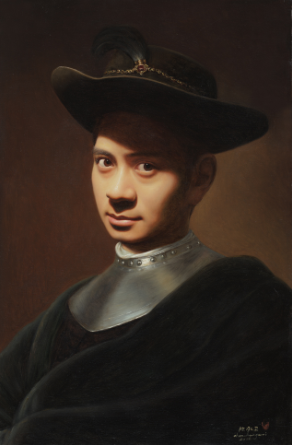
Rembrandt painted 61 self-portraits in his whole life. And in this series of self-portraits, we can tell Rembrandt’s unyielding character. He devoted himself to the painting of his skin, hair and texture, bravely recording his sorrow, sadness, freedom and happiness and such depictions and self-analysis were viewed as dignity in his life. The same is true with the works of Chen Chengwei. He always looks straight at the outside world inside the painting, smiling, no matter he wears a hat looking like a jester or dresses like an aristocrat. Watching his self-portraits, you can feel a strong sense of confidence that as long as he keeps on painting, his dignity will never cease.
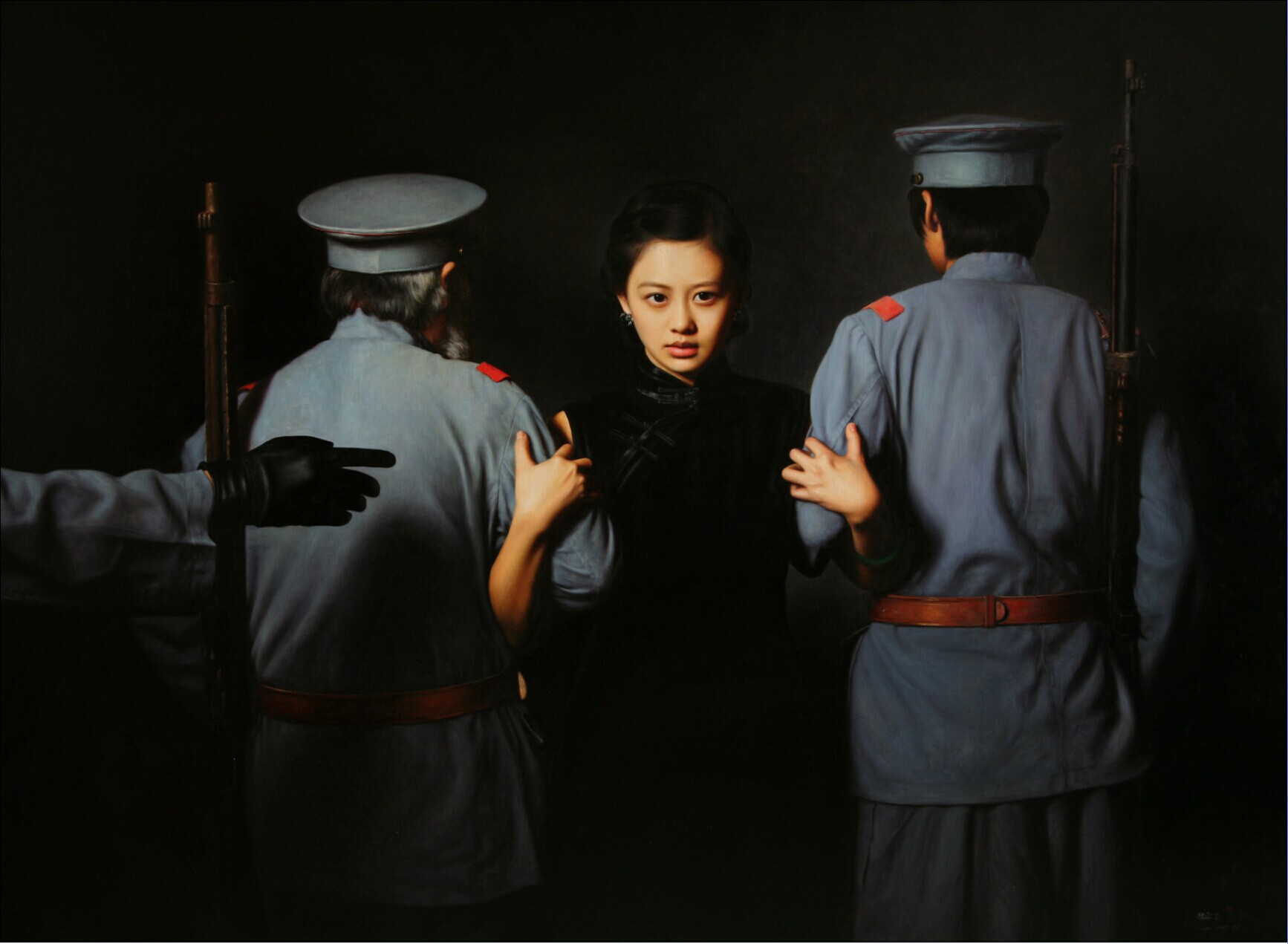
Besides, dramatic features also play an important role in Chen’s works, especially the depiction of symbolic nature in the era of the Republic of China in the “Republic of China” series. Like the above-mentioned Velazquez, this artist put himself in interspersing in various scenes of the Republic of China, seeking himself in depression and experiencing various scenes and various lives. He perfectly combined realism with the current classical aesthetics in China and integrated his imagination into his works with his mature painting skills. Red silks and satin scattering in each work have political implications and are a metaphor of women suffering under the yoke of traditional marriage. On the other hand, what is striking and precious is that although Chen Chengwei is a young artist, we can see from the progress of his artistic expressions an increasingly complicated artistic expressions and thinking instead of pulp and plain streamlining creation due to aesthetic convergence or interests. The most prominent work that shows the growth of this artist is the depiction of Red Rose and White Rose, the masterpiece of Ms. Eileen Chang. Rich symbols are hidden in the work, depicting incisively and vividly the mentality of Zhenbao, the male protagonist in the novel. “Perhaps each man had such two women, at least two. After marrying Red Rose, as times passed, the Red became a touch of mosquito blood on the wall while the White was still a ray of moonlight in front of the bed; after marrying White Rose, the White became a grain of rice clinging to the clothes while the Red was still a cinnabar mole on the man’s heart.” In Red Rose, the man wears a red hat but cloth in white. The Red Rose is a cinnabar mole in the heart of Zhenbao, even though he is wearing white wedding suits to marry White Rose, he is still anxious to send the red rose symbolizing heart and enthusiasm to the lady in red, but this rose has already begun withering or has never been in full blossom, just like the subsequent stories in the novel, that is, when the Red Rose finally turns around and sincerely faces the relationship with Zhenbao, Zhenbao chooses to leave cowardly. And White Rose is like a sequel to the former work. In front of the red satin flowers, the couple in white look at each other without facial expression or passion. A white rose on the white bellyband is in front of the red decorative pattern symbolizing heart and passion while the man crosses his hands defensively. This, perhaps, is the traditional couple who are always courteous to each other, but there is an invisible thousand-mile barrier between them although they are standing together; however, another hand from outside the painting reaches the shoulder of the lady, implying that in the future Zhenbao will finally discover the affair between his wife and the tailor.
I believe, therefore, Chen has kept making progresses through his explorations of self-portrait painting. He has been trying to find another self in different space and time by painting.
Dr. Gao Peng
Director of Today Art Museum
Written on August 17, 2015 in Beijing






